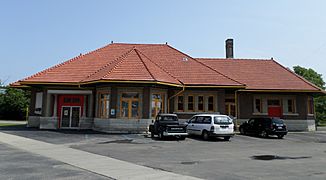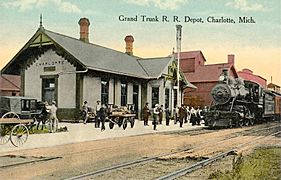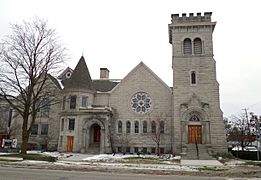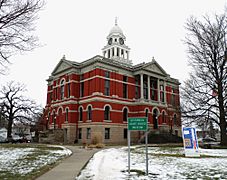Charlotte Central Historic District facts for kids
Quick facts for kids |
|
|
Charlotte Central Historic District
|
|
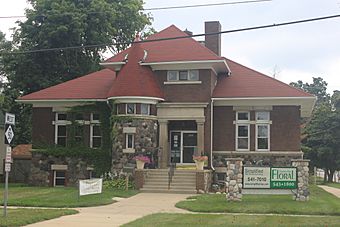
Carnegie Library
|
|
| Location | Cochran Ave. & adjacent streets; West McClure St. to south of Henry St., Charlotte, Michigan |
|---|---|
| NRHP reference No. | 100002684 |
| Added to NRHP | October 16, 2020 |
The Charlotte Central Historic District is a special area in downtown Charlotte, Michigan. It's a place where you can find many old shops, homes, and other important buildings. This district was added to the National Register of Historic Places in 2020. This means it's recognized as a historically important place in the United States.
Contents
What is the Charlotte Central Historic District?
This historic district has 328 buildings. About 288 of these buildings are considered important to the district's history. You can find the main shopping area of Charlotte here. There are also old neighborhoods with both large, fancy houses and smaller, simpler homes.
The district also includes some early factory buildings. You can find other structures near the old railroad tracks. Most of these buildings have two floors. They were built mostly in the late 1800s. You'll see different styles of buildings here. Some look like old Italian buildings, and others are from the Victorian era. The homes show styles like Greek Revival and Queen Anne.
Important Buildings to See
Many buildings in the district are very special. Some are even listed on the National Register of Historic Places by themselves! Here are a few:
- The Eaton County Courthouse: Built in 1885, this old courthouse is now a museum.
- The First Congregational Church: This church was built in 1881.
- The Michigan Central Railroad depot: This train station was built in 1902.
- The Grand Trunk Western Railroad depot: Another train station, built in 1885.
- The Lawrence Avenue Methodist Church: This church was built in 1902–03.
- The Carnegie Library: A library built in 1903, thanks to a gift from Andrew Carnegie.
- The Masonic Temple: This building was constructed in 1904.
- The old High School: Built in 1914, with additions in 1936 and 1955.
- The U. S. Post Office: This building was finished in 1917.
- The Michigan Bell Telephone Building: Built in 1929.
- The Eaton Theatre: A movie theater built in 1931.
When was Charlotte Central Historic District Built?
The town of Charlotte was first planned out in 1838. The number of people living here grew steadily. Charlotte became a village in 1863. A few of the oldest buildings in the district are from this time. For example, a county building at 115 W. Lawrence was built around 1841. Some Greek Revival style houses also date back to the mid-1800s.
How Railroads Helped Charlotte Grow
The arrival of railroads really helped Charlotte grow. The Grand River Valley Railroad came in 1868. The Peninsular Railroad arrived in 1870. By 1871, Charlotte was big enough to become a city. Many of the oldest commercial buildings were built around this time. They are mostly found near the courthouse.
Charlotte grew a lot during the 1880s. Almost one-third of the buildings in the district were built in the last 20 years of the 1800s. This includes many of the largest public buildings and homes.
Another one-third of the buildings were built in the early 1900s. However, as the city became more developed and the Great Depression happened, new construction slowed down. Building new places became much less common after 1950.
Gallery




